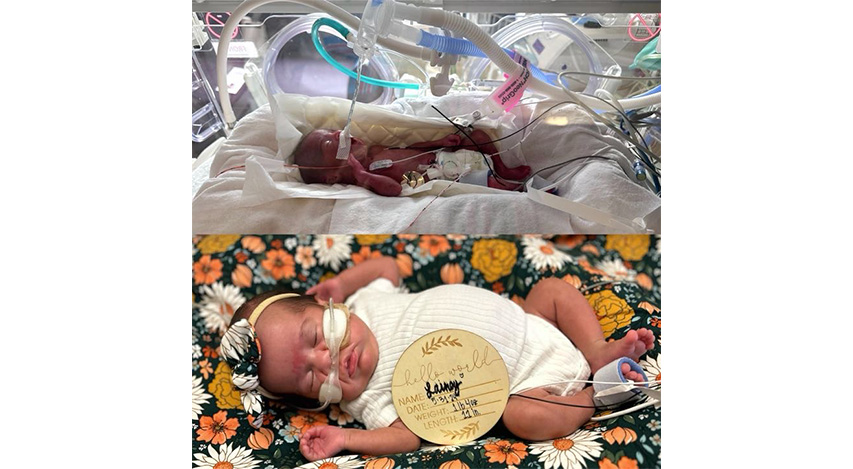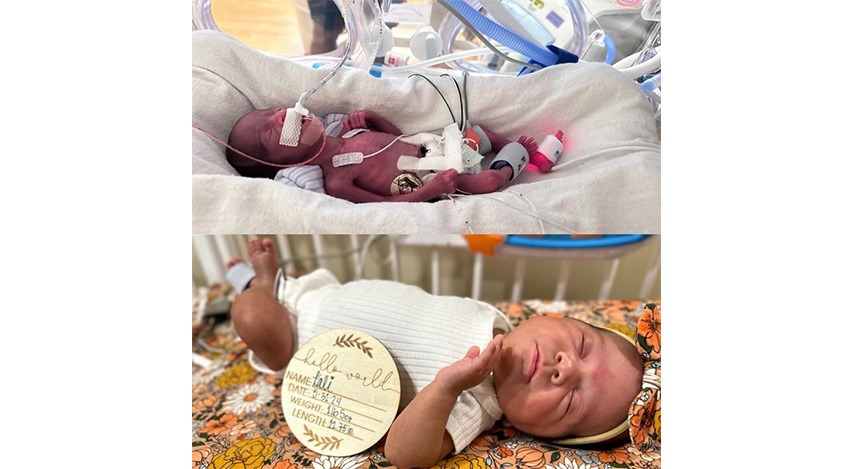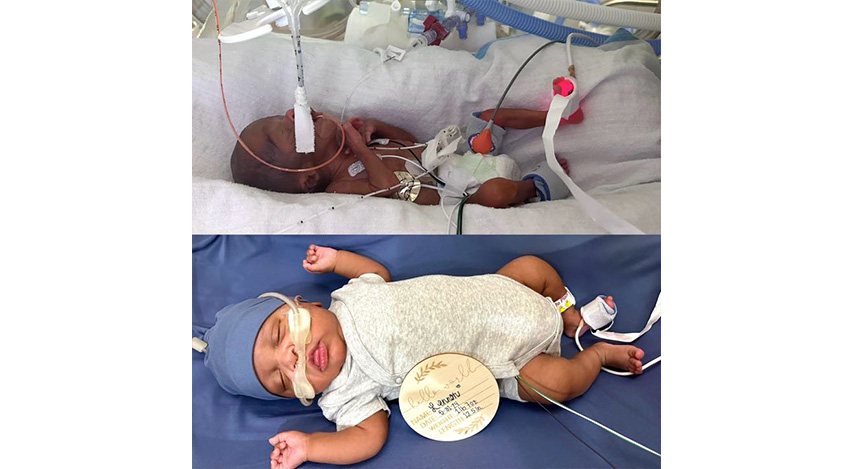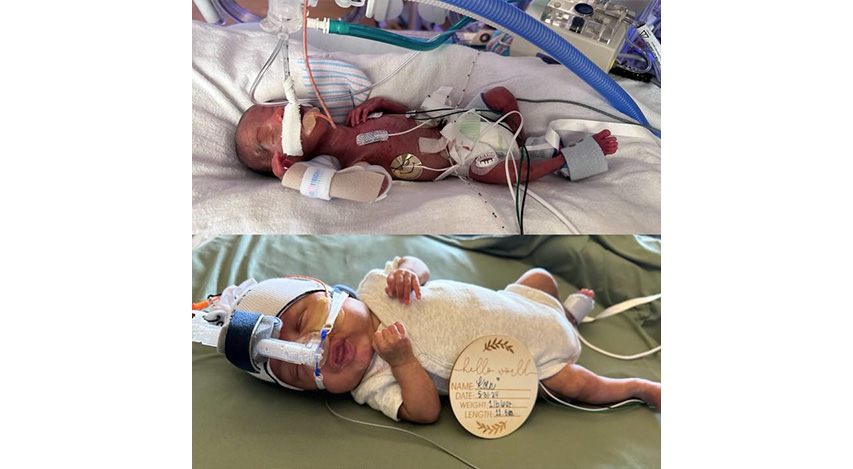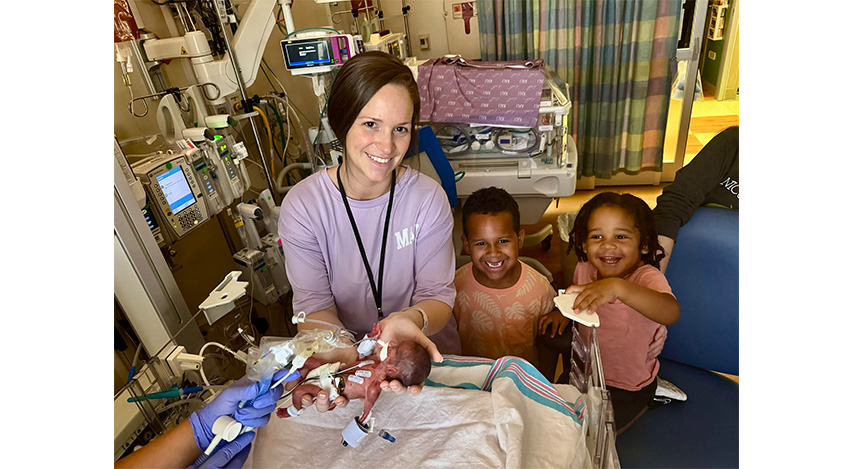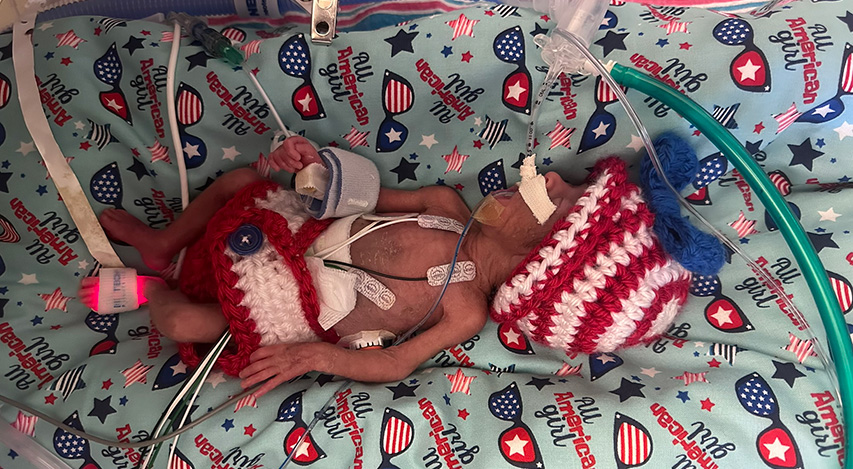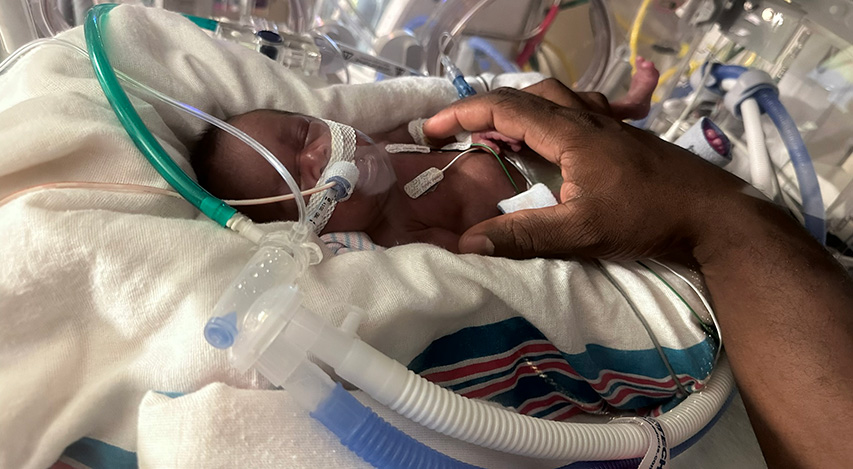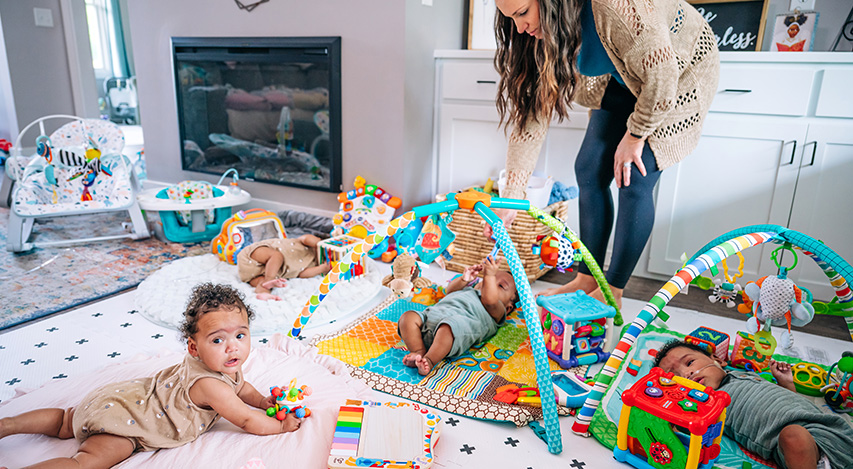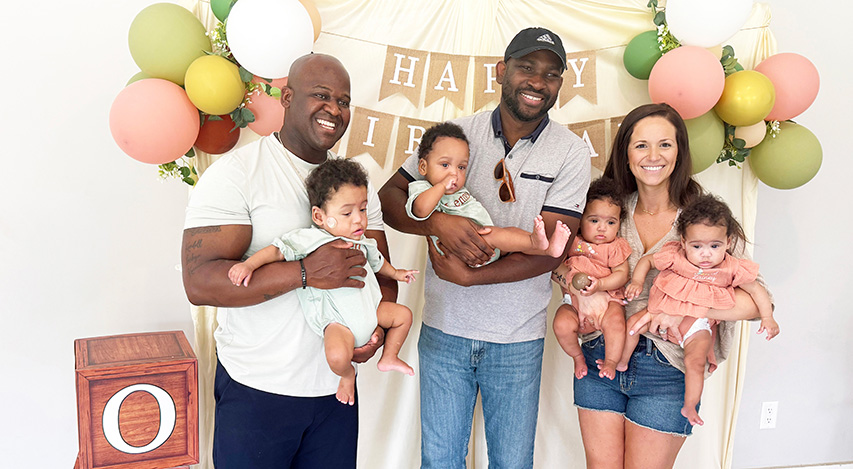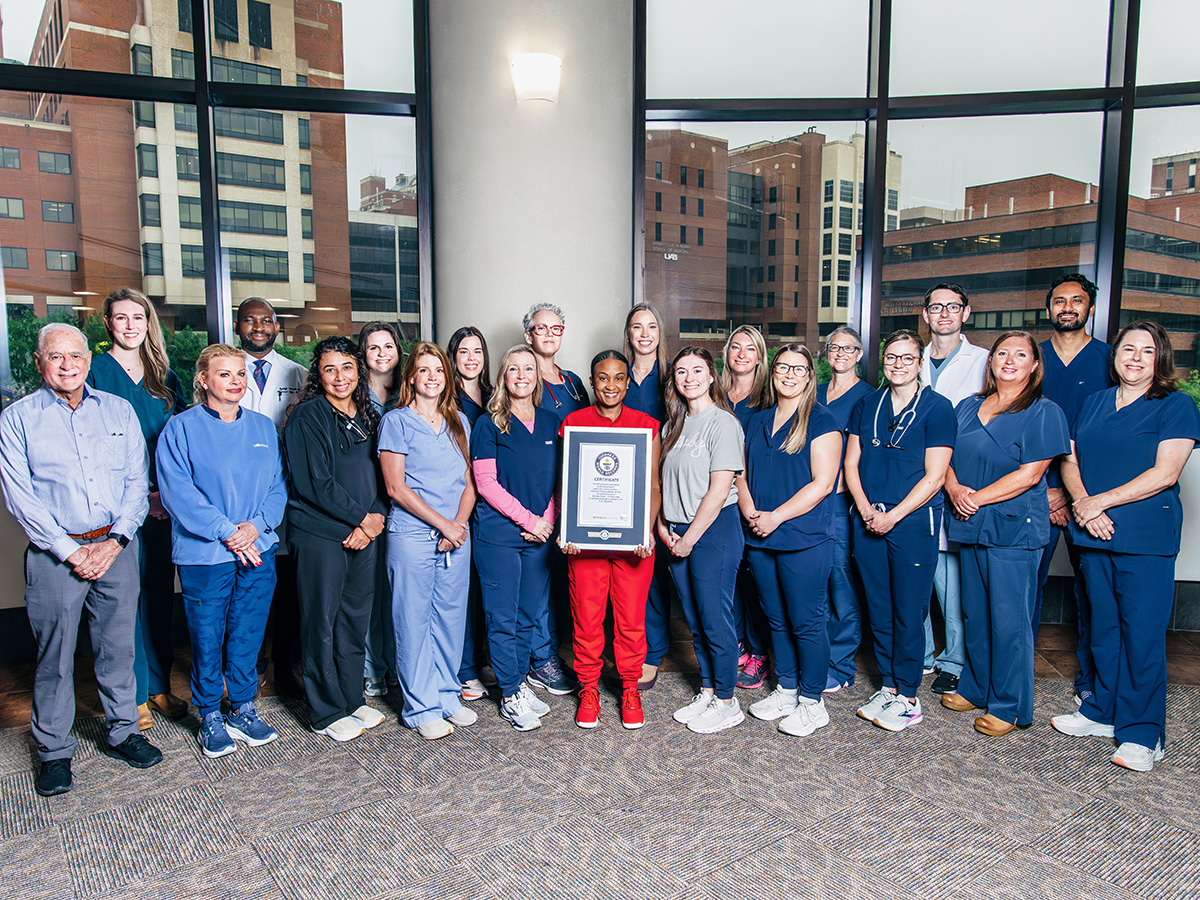 Members from the Bryants maternal-fetal medicine and neonatology team gathered in the UAB Women and Infants Center to celebrate delivering, and saving, the world's most premature quadruplets. (Photography: Jennifer Alsabrook-Turner)In the early morning hours of Friday, May 31, 2024, around 30 maternal-fetal and neonatology experts filled an operating room at the University of Alabama at Birmingham Hospital. They were called in for an emergency cesarean delivery of quadruplets who were only 23 weeks and four days’ gestation.
Members from the Bryants maternal-fetal medicine and neonatology team gathered in the UAB Women and Infants Center to celebrate delivering, and saving, the world's most premature quadruplets. (Photography: Jennifer Alsabrook-Turner)In the early morning hours of Friday, May 31, 2024, around 30 maternal-fetal and neonatology experts filled an operating room at the University of Alabama at Birmingham Hospital. They were called in for an emergency cesarean delivery of quadruplets who were only 23 weeks and four days’ gestation.
As the babies were quickly delivered, the interdisciplinary team of physicians, nurses and respiratory therapists jumped into action, fighting to keep the babies alive.
Little did they know, they had delivered — and were going to save — the Guinness World Records title holders for the most premature quadruplets, breaking the record set back in 1997.
“When Lainey, Kali, Lennon and Koen were born, they were 115 days premature,” said Becca Bryant, the quads’ mom. “A year later, we were surrounded by family and friends to celebrate their first birthday. It was a moment we were not sure we’d ever see.”
Two plus two equals four
In February 2024, Becca and Lavareis Bryant attended a routine ultrasound appointment in their hometown of Auburn, Alabama. With three older children, the couple was excited to get their first glance at their fourth baby. They were also nervous as they had recently experienced a miscarriage.
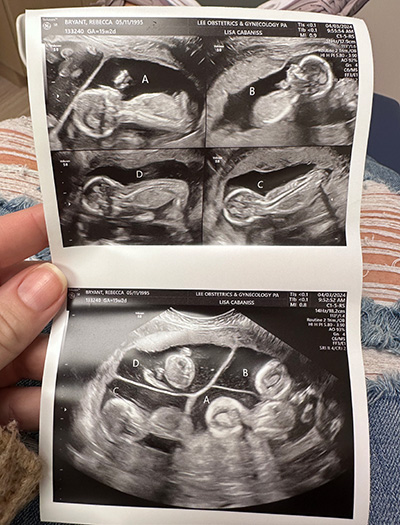 Becca had a trichorionic quadra-amniotic pregnancy, meaning there were four babies and four sacs but only three placentas. (Photography provided by Becca Bryant)“The ultrasound tech started moving the machine around, and I started to notice one big spot and two smaller ones,” Lavareis said. “The next thing I know, she’s counting — 1 … 2 … 3 … 4!”
Becca had a trichorionic quadra-amniotic pregnancy, meaning there were four babies and four sacs but only three placentas. (Photography provided by Becca Bryant)“The ultrasound tech started moving the machine around, and I started to notice one big spot and two smaller ones,” Lavareis said. “The next thing I know, she’s counting — 1 … 2 … 3 … 4!”
They stared at each other in disbelief. The final baby of the family was actually four babies. Becca’s pregnancy was now considered high-risk. Her obstetrician referred her to the UAB maternal-fetal medicine team, who specializes in high-risk obstetrics and unique pregnancies.
Multiple pregnancies are rare, with twins occurring in one in 80 and quadruplets occurring in one in 700,000. Becca had a trichorionic quadra-amniotic pregnancy, meaning there were four babies and four sacs but only three placentas.
“The odds of this specific type of quads are around one in 7 million,” said Ayodeji Sanusi, M.D., Becca’s maternal-fetal medicine physician at UAB. “Three eggs were fertilized; but one split, making two of the babies identical and two fraternal. It also added on to the complex and high-risk nature of her pregnancy.”
Carrying more babies means an increased risk of complications, including preterm birth. To minimize these risks, Becca alternated weekly scans at her local obstetrician and the UAB Women and Infants Center.
Minimizing risk for better chances for survival
Around 19 weeks, her cervix started to shorten, a potential sign of oncoming labor. When her cervix had shortened more by her next appointment, Becca was admitted to UAB Hospital for continual monitoring for the duration of the pregnancy.
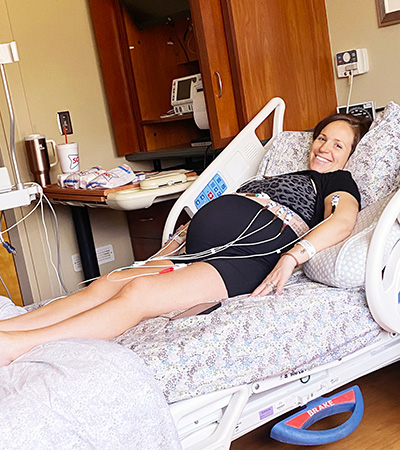 Becca was admitted to UAB Hospital for continual monitoring after her cervix started to shorten. (Photography provided by Becca Bryant)“We didn’t want to take the chance that I would go into preterm labor, or a complication arise with the babies, and I be over two hours away,” Becca said. “It was hard to leave my other kids; but I knew how important it was for me to be at UAB, where they had the resources and expertise needed to care for us.”
Becca was admitted to UAB Hospital for continual monitoring after her cervix started to shorten. (Photography provided by Becca Bryant)“We didn’t want to take the chance that I would go into preterm labor, or a complication arise with the babies, and I be over two hours away,” Becca said. “It was hard to leave my other kids; but I knew how important it was for me to be at UAB, where they had the resources and expertise needed to care for us.”
The original goal was to get the babies to at least 32 weeks’ gestation, to balance the risks of prematurity and those of continuing pregnancy. Once Becca’s cervix shortened, the goal became 28 weeks.
A few weeks later, Lavareis arrived at UAB for a routine visit with Becca when her water suddenly broke. She was only 23 weeks and three days along, but did not experience additional signs of labor. Her care team was hopeful that they could delay delivery a little longer and adjust to a new plan.
That night, Becca developed a high fever and abdominal tenderness, and both her and the babies’ heart rates started racing. The signs pointed to an infection, most likely due to her water breaking. The more she waited, the higher the risk to her and the babies’ lives.
“After discussions with the Bryants and the neonatology team, it was mutually decided to proceed with an emergency c-section knowing the risks of severe prematurity,” said Sanusi, who is also an assistant professor in the UAB Department of Obstetrics and Gynecology. “It was an all-hands-on-deck situation. We even had team members who were not working come in to assist.”
The Bryant quads made their entry into the world on May 31, 2024 — Lainey at 2:15, Kali at 2:16, Lennon at 2:17 and Koen at 2:20 a.m.
Defeating the odds
The neonatology team rushed the quads to the Level IV UAB Regional Newborn Intensive Care Unit, where they started UAB Golden Week protocols.
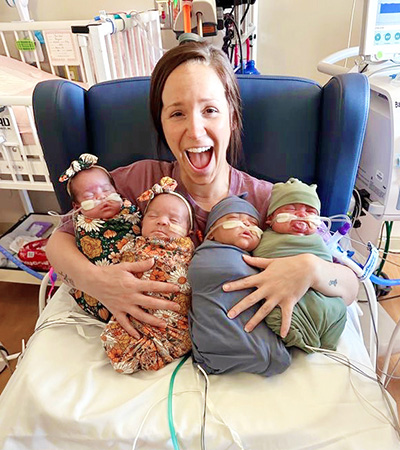 Becca holds the quads all together for the first time. (L to R: Lainey, Kali, Lennon, and Koen) (Photography provided by Becca Bryant)“The highest risk of complications and mortality for extremely preterm babies occurs during their first week of life,” said Colm Travers, M.D., neonatologist and director of the UAB Golden Week program. “The program focuses on minimizing complications in babies through that first critical week because it typically means a greater chance of survival and going home.”
Becca holds the quads all together for the first time. (L to R: Lainey, Kali, Lennon, and Koen) (Photography provided by Becca Bryant)“The highest risk of complications and mortality for extremely preterm babies occurs during their first week of life,” said Colm Travers, M.D., neonatologist and director of the UAB Golden Week program. “The program focuses on minimizing complications in babies through that first critical week because it typically means a greater chance of survival and going home.”
Surviving the first week was only the beginning. Babies born severely premature can face complications including severe brain bleeds, chronic lung disease, bowel injury, infections and sepsis. Each of the quads required multiple forms of ventilation, medications and numerous central lines. All experienced their own medical challenges as well.
“There were so many times we were so close to losing one of them,” Becca said. “But I kept saying ‘We came in with four, and we’re taking four home.’ We were going to do whatever it took to get there.”
Over the next five months, the quads received 24/7 care and monitoring. Becca rarely left their side, while Lavareis juggled work and taking care of the older kids, Kendall, Laikyn and Kainen, and visits to Birmingham.
Little by little, the quads began to grow and improve. The numerous machines that kept them alive were slowly taken away as the quads’ own strength took over. In November, they were all stable enough to be transferred down to the UAB Continuing Care Nursery, a milestone for RNICU babies.
Shortly after, the Bryants received news they were unsure they would ever hear — the babies were ready to go home.
“In the span of a month, all four babies were discharged, right in time for Christmas at home,” Becca said. “It was surreal leaving a place that had become our second home and the staff who had become like family.”
Guinness World Record Holders
When Travers first met the Bryants, he discussed the risk, complications and chances of survival for babies born at 23 weeks. He also realized he did not know of another instance where quads were born that early and all four babies survived.
 On May 31, 2025, the Bryant quads celebrated their first birthday and becoming the Guinness World Records title holders for most premature quadruplets. (Photography provided by Becca Bryant)As part of their delivery and care team, he and his colleagues in the UAB RNICU spent the next six months tirelessly working to help the babies survive and thrive. Travers, who is also an associate professor in the UAB Department of Pediatrics, secretly continued his research into the records of extremely premature babies.
On May 31, 2025, the Bryant quads celebrated their first birthday and becoming the Guinness World Records title holders for most premature quadruplets. (Photography provided by Becca Bryant)As part of their delivery and care team, he and his colleagues in the UAB RNICU spent the next six months tirelessly working to help the babies survive and thrive. Travers, who is also an associate professor in the UAB Department of Pediatrics, secretly continued his research into the records of extremely premature babies.
Before the last baby was discharged, Travers had one more conversation with Becca and Lavareis.
“When my search came up empty, I realized there was a high chance the Bryant quads were the most premature quads to survive in the world,” Travers said. “Being able to tell them the exciting news, especially when our first conversation was not as optimistic, was a full-circle moment.”
The couple was, once again, in disbelief.
“Hearing our babies were the most premature quads put into perspective how lucky we were that all of them made it,” Becca said. “We had our family and friends, as well as the UAB team, there the whole way. Fighting for our babies, fighting for our family.”
A year later, and the quads are happy 1-year-olds. Koen and Lainey still require a nasal cannula, and Lennon has a G tube to help supplement his feeding. The family continues making trips to the UAB Newborn Follow-Up Clinic and Children’s of Alabama to ensure the quads develop appropriately.
Overall, they continue to hit milestones and defy the odds they were given at birth.
“I think it is a testament to the quality and kind of care that we can provide to these families at UAB,” Sanusi said. “It shows how well trained and how closely we work with all specialties to make world records like this possible, even though that is not the intention going into it.”
-
Lainey after birth versus her due date. Photography provided by Becca Bryant
-
Kali after birth versus her due date. Photography provided by Becca Bryant
-
Lennon after birth versus his due date. Photography provided by Becca Bryant
-
Koen after birth versus his due date. Photography provided by Becca Bryant
-
Becca holds Lainey with Laikyn and Kainen. Photography provided by Becca Bryant
-
Kali at a few weeks old. Photography provided by Becca Bryant
-
Lennon gets a “hand hug” from Lavareis. Photography provided by Becca Bryant
-
Becca holds Kali and Lavareis holds Lenon during feeding time. Photography: Jeff Myers
-
Becca plays with the quads. Front: Kali; Back: Lainey, Lennon, Koen Photography: Jeff Myers
-
Sanusi joins the Bryant family to celebrate the quads’ first birthday. L to R: Lavareis holds Koen, Sanusi holds Lennon, Becca holds Kali and Lainey. Photography provided by Becca Bryant
